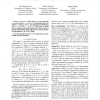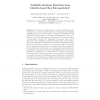397 search results - page 8 / 80 » Pseudorandom Functions and Lattices |
JOC
1998
13 years 6 months ago
1998
We describe a software-e cient encryption algorithm named SEAL 3.0. Computational cost on a modern 32-bit processor is about 4 clock cycles per byte of text. The cipher is a pseudo...
CRYPTO
2007
Springer
14 years 1 months ago
2007
Springer
At Crypto ’06, Bellare presented new security proofs for HMAC and NMAC, under the assumption that the underlying compression function is a pseudo-random function family. Converse...
FOCS
2010
IEEE
13 years 5 months ago
2010
IEEE
For an n-variate degree
EUROCRYPT
2009
Springer
14 years 7 months ago
2009
Springer
We propose a methodology to construct verifiable random functions from a class of identity based key encapsulation mechanisms (IB-KEM) that we call VRF suitable. Informally, an IB-...
ASIACRYPT
2006
Springer
13 years 10 months ago
2006
Springer
In this paper, we describe generic attacks on unbalanced Feistel schemes with contracting functions. These schemes are used to construct pseudo-random permutations from kn bits to ...


